冀教版七年级英语上册教案
- 格式:doc
- 大小:24.50 KB
- 文档页数:8
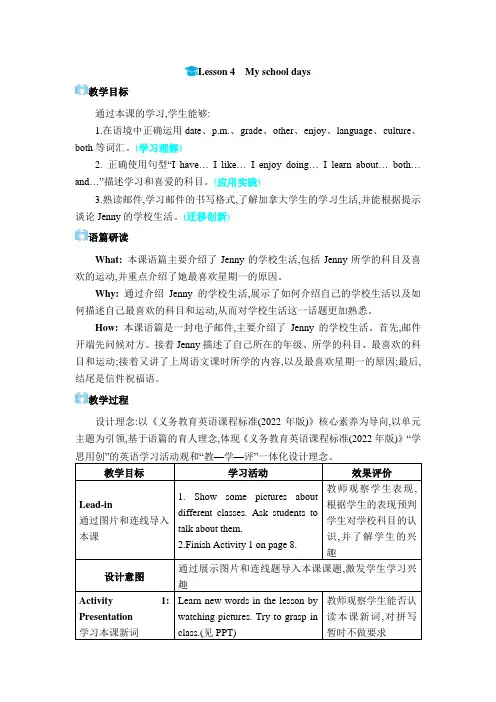
Lesson 4My school days教学目标通过本课的学习,学生能够:1.在语境中正确运用date、p.m.、grade、other、enjoy、language、culture、both等词汇。
(学习理解)2. 正确使用句型“I have… I like… I enjoy doing… I learn about… both… and…”描述学习和喜爱的科目。
(应用实践)3.熟读邮件,学习邮件的书写格式,了解加拿大学生的学习生活,并能根据提示谈论Jenny的学校生活。
(迁移创新)语篇研读What: 本课语篇主要介绍了Jenny的学校生活,包括Jenny所学的科目及喜欢的运动,并重点介绍了她最喜欢星期一的原因。
Why: 通过介绍Jenny的学校生活,展示了如何介绍自己的学校生活以及如何描述自己最喜欢的科目和运动,从而对学校生活这一话题更加熟悉。
How: 本课语篇是一封电子邮件,主要介绍了Jenny的学校生活。
首先,邮件开端先问候对方。
接着Jenny描述了自己所在的年级、所学的科目、最喜欢的科目和运动;接着又讲了上周语文课时所学的内容,以及最喜欢星期一的原因;最后,结尾是信件祝福语。
教学过程设计理念:以《义务教育英语课程标准(2022年版)》核心素养为导向,以单元主题为引领,基于语篇的育人理念,体现《义务教育英语课程标准(2022年版)》“学两人对话否用自己的语言表达最喜爱学校日以及原因设计意图学习用所学词汇和相关的表达谈论自己最喜欢的学校日和喜欢的原因,在真实情景中达到学以致用【迁移创新】板书设计Lesson 4My school days— What subject do you have?—I have…— Which subject/school day do you like best?—My favourite subject/school day is…— Why?—I like/enjoy…作业设计基础型作业:1.Read the passage fluently.2.Prepare a photo of yourself for the next lesson.实践型作业:Make a dialogue with your partner about school subjects. 教学反思。
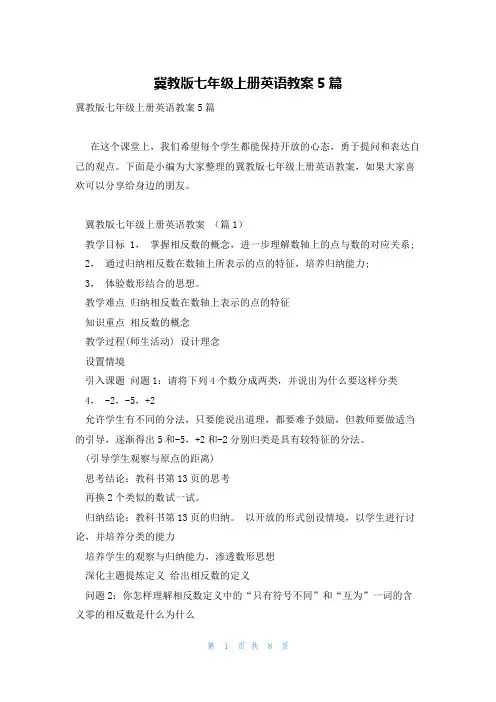
冀教版七年级上册英语教案5篇冀教版七年级上册英语教案5篇在这个课堂上,我们希望每个学生都能保持开放的心态,勇于提问和表达自己的观点。
下面是小编为大家整理的冀教版七年级上册英语教案,如果大家喜欢可以分享给身边的朋友。
冀教版七年级上册英语教案(篇1)教学目标 1,掌握相反数的概念,进一步理解数轴上的点与数的对应关系; 2,通过归纳相反数在数轴上所表示的点的特征,培养归纳能力;3,体验数形结合的思想。
教学难点归纳相反数在数轴上表示的点的特征知识重点相反数的概念教学过程(师生活动) 设计理念设置情境引入课题问题1:请将下列4个数分成两类,并说出为什么要这样分类4, -2,-5,+2允许学生有不同的分法,只要能说出道理,都要难予鼓励,但教师要做适当的引导,逐渐得出5和-5,+2和-2分别归类是具有较特征的分法。
(引导学生观察与原点的距离)思考结论:教科书第13页的思考再换2个类似的数试一试。
归纳结论:教科书第13页的归纳。
以开放的形式创设情境,以学生进行讨论,并培养分类的能力培养学生的观察与归纳能力,渗透数形思想深化主题提炼定义给出相反数的定义问题2:你怎样理解相反数定义中的“只有符号不同”和“互为”一词的含义零的相反数是什么为什么学生思考讨论交流,教师归纳总结。
规律:一般地,数a的相反数可以表示为-a思考:数轴上表示相反数的两个点和原点有什么关系练一练:教科书第14页第一个练习体验对称的图形的特点,为相反数在数轴上的特征做准备。
深化相反数的概念;“零的相反数是零”是相反数定义的一部分。
强化互为相反数的数在数轴上表示的点的几何意义给出规律解决问题问题3:-(+5)和-(-5)分别表示什么意思你能化简它们吗学生交流。
分别表示+5和-5的相反数是-5和+5练一练:教科书第14页第二个练习利用相反数的概念得出求一个数的相反数的方法小结与作业课堂小结 1,相反数的定义2,互为相反数的数在数轴上表示的点的特征3,怎样求一个数的相反数怎样表示一个数的相反数本课作业 1,必做题教科书第18页习题1.2第3题2,选做题教师自行安排本课教育评注(课堂设计理念,实际教学效果及改进设想)1,相反数的概念使有理数的各个运算法则容易表述,也揭示了两个特殊数的特征.这两个特殊数在数量上具有相同的绝对值,它们的和为零,在数轴上表示时,离开原点的距离相等等性质均有广泛的应用.所以本教学设计围绕数量和几何意义展开,渗透数形结合的思想.2,教学引人以开放式的问题人手,培养学生的分类和发散思维的能力;把数在数轴上表示出来并观察它们的特征,在复习数轴知识的同时,渗透了数形结合的数学方法,数与形的相互转化也能加深对相反数概念的理解;问题2能帮助学生准确把握相反数的概念;问题3实际上给出了求一个数的相反数的方法.3,本教学设计体现了新课标的教学理念,学生在教师的引导下进行自主学习,自主探究,观察归纳,重视学生的思维过程,并给学生留有发挥的余地. 冀教版七年级上册英语教案(篇2)教学目的1.通过对多个实际问题的分析,使学生体会到一元一次方程作为实际问题的数学模型的作用。
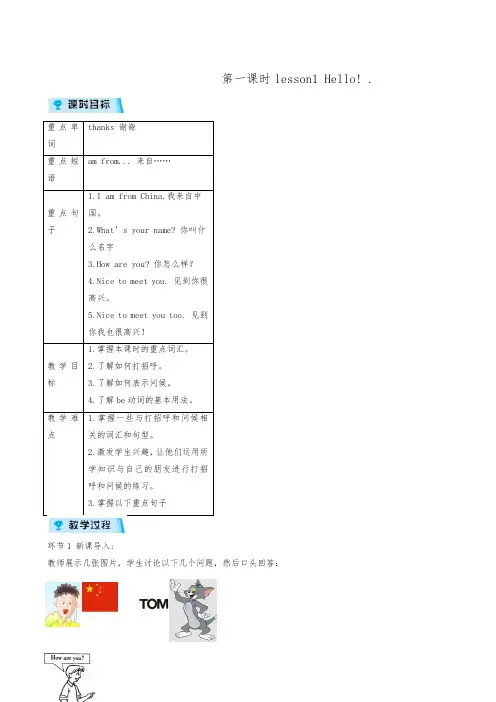
第一课时lesson1 Hello! .环节1 新课导入:教师展示几张图片,学生讨论以下几个问题,然后口头回答:(1)Where is Mingming from?(2)What’s the name of the cat?(3)Someone say: “How are you?, and you say: “!”(4)Someone say: “Nice to meet you!”And you say: “ !”设计意图:通过图片引入,引起学生疑问,激发学生对见面问好的兴趣,为新课做准备。
环节2 学习活动1.听录音,听完讨论并口头回答以下问题:(1)Where is Danny from?(2)How is Li Ming?2.教师教读本课的对话内容,然后同桌一起练习,熟读对话。
3.教师请几对同学起来表演。
指出学生表现得好的地方和不足之处,要适当鼓励。
4.听练习题1的录音,大家跟着录音一起唱。
5.学生四人为一组,编对话,相互询问对方的姓名,国籍等问题。
对话中要用到下列句子:What’s your name?How are you?Where are you from?Nice to meet you.6.教师请三组学生起来表演他们的对话,然后作点评。
表现得好的小组获得奖励。
7.教师随机抽取四名学生到讲台上表演,参照练习题2的游戏进行对话,教师在一边指导和配合表演。
8.学生完成练习题3,按打招呼的正确顺序,题中的三句话排序。
9.学以致用。
(1)同义句转换:I am Jenny.My name is Jenny.(2)用be的正确形式完成对话。
Joe: Hello. I am Joe. What is your name?Sue:My name is Sue.(3)根据句意完成对话。
Joe: Hi,nice to meet you!Sue:Hi, nice to meet you, too.设计意图:通过简单的自我介绍练习和日常见面打招呼的方式,让学生初步学会如何用英语介绍自己、问候对方。
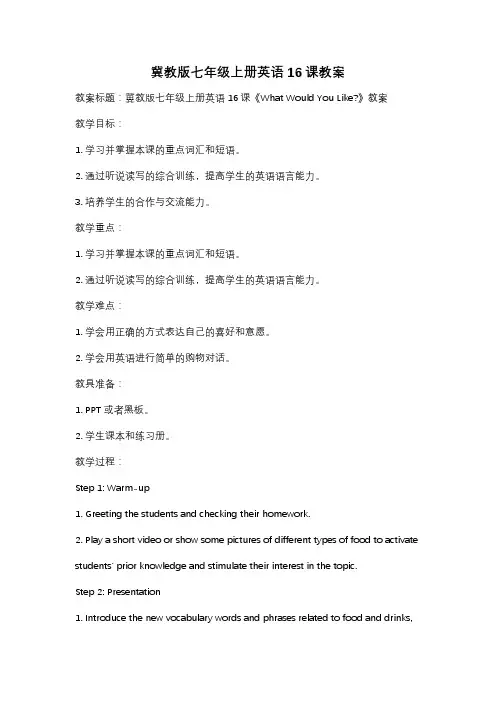
冀教版七年级上册英语16课教案教案标题:冀教版七年级上册英语16课《What Would You Like?》教案教学目标:1. 学习并掌握本课的重点词汇和短语。
2. 通过听说读写的综合训练,提高学生的英语语言能力。
3. 培养学生的合作与交流能力。
教学重点:1. 学习并掌握本课的重点词汇和短语。
2. 通过听说读写的综合训练,提高学生的英语语言能力。
教学难点:1. 学会用正确的方式表达自己的喜好和意愿。
2. 学会用英语进行简单的购物对话。
教具准备:1. PPT或者黑板。
2. 学生课本和练习册。
教学过程:Step 1: Warm-up1. Greeting the students and checking their homework.2. Play a short video or show some pictures of different types of food to activate students' prior knowledge and stimulate their interest in the topic.Step 2: Presentation1. Introduce the new vocabulary words and phrases related to food and drinks,such as "hamburger", "chicken", "noodles", "coffee", "tea", etc.2. Use realia or pictures to help students understand the meaning of the words and practice pronunciation.Step 3: Listening1. Play the audio recording of the dialogue in the textbook.2. Ask students to listen and try to understand the dialogue.3. Play the audio again and have students repeat after the recording to practice pronunciation.Step 4: Speaking1. Divide the class into pairs or small groups.2. Have students role-play the dialogue in pairs, using the new vocabulary words and phrases.3. Monitor the students' conversations and provide feedback and guidance. Step 5: Reading1. Ask students to read the dialogue in the textbook silently.2. Have volunteers read the dialogue aloud to the class.3. Discuss the meaning of any unfamiliar words or phrases and provide explanations if necessary.Step 6: Writing1. Ask students to write a short paragraph about their favorite food or drink.2. Encourage students to use the new vocabulary words and phrases they have learned in their writing.3. Collect and review the students' writing assignments, providing feedback and corrections.Step 7: Consolidation and Extension1. Play a game, such as "Guess the Food", where students take turns describing a food item and the others have to guess what it is.2. Assign extra practice exercises from the textbook or workbook to reinforce the lesson's vocabulary and grammar points.Step 8: Summary and Homework1. Summarize the key points of the lesson and review the new vocabulary words and phrases.2. Assign homework, such as completing the exercises in the workbook or writing a short dialogue using the new vocabulary words and phrases.教学反思:本节课以《What Would You Like?》为主题,通过听说读写的综合训练,旨在提高学生的英语语言能力。
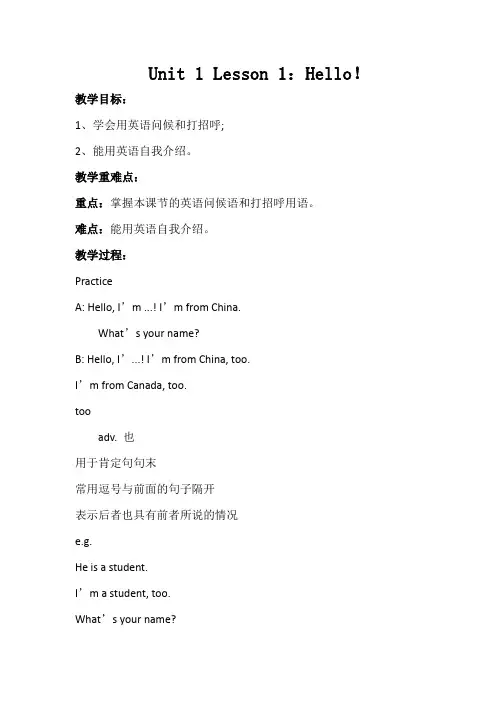
Unit 1 Lesson 1:Hello!教学目标:1、学会用英语问候和打招呼;2、能用英语自我介绍。
教学重难点:重点:掌握本课节的英语问候语和打招呼用语。
难点:能用英语自我介绍。
教学过程:PracticeA: Hello, I’m ...! I’m from China.What’s your name?B: Hello, I’...! I’m from China, too.I’m from Canada, too.tooadv. 也用于肯定句句末常用逗号与前面的句子隔开表示后者也具有前者所说的情况e.g.He is a student.I’m a student, too.What’s your name?What’s your name?你叫什么名字?询问他人姓名的句型;回答时用My name is …或者直接回答姓名。
How are you?How are you?你好吗?打招呼的常用语用于询问对方的身心状态怎么样回答时用I’m fine.或Fine/Very well.等Sing the song with the students’own names. Hello, hello, how are you?What’s your name?My name is ....Hello, hello, how are you?What’s your name?My name is ....Hello, hello, how are you?Fine. Nice to meet you.Stop and Go! Play this game to practice greeting your friends.A: Hello! My name is .... What’s your name?B: Hi! My name is .... How are you?A: I’m fine. Nice to meet you!How can you introduce yourself to a new friend? Number the sentences in the correct order._______ I’m from Canada,_______ Hello! I’m Danny._______ Nice to meet you.Sum up1. Hello, I'm ....2. I'm from ....3. A:What's your name?B:My name is ....4. A:How are you?B: Fine, thanks.5. A: Nice to meet you.B: Nice to meet you, too.根据汉语或首字母提示完成句子1.I (是)Jenny.2.Jenny is from (加拿大).3.My name (是) Wang Mei.4.—W is your name, please?—I’m Tony.5.Li Ming is from Beijing, C .根据汉语意思完成句子。
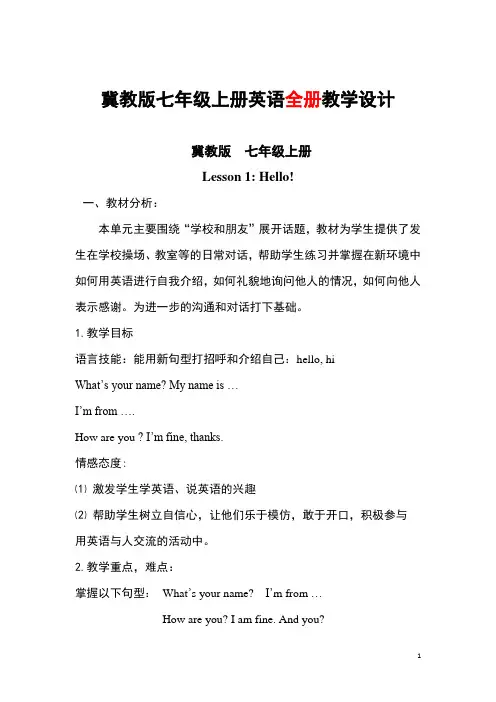
冀教版七年级上册英语全册教学设计冀教版七年级上册Lesson 1: Hello!一、教材分析:本单元主要围绕“学校和朋友”展开话题,教材为学生提供了发生在学校操场、教室等的日常对话,帮助学生练习并掌握在新环境中如何用英语进行自我介绍,如何礼貌地询问他人的情况,如何向他人表示感谢。
为进一步的沟通和对话打下基础。
1.教学目标语言技能:能用新句型打招呼和介绍自己:hello, hiWhat’s your name? My name is …I’m from ….How are you ? I’m fine, thanks.情感态度:⑴激发学生学英语、说英语的兴趣⑵帮助学生树立自信心,让他们乐于模仿,敢于开口,积极参与用英语与人交流的活动中。
2.教学重点,难点:掌握以下句型:What’s your name? I’m from …How are you? I am fine. And you?二、教学准备:磁带,录音机三、教学步骤:Step I Class openingTs: How are you? How are you? How are you today?Ss: I am fine, thanks. I am fine, thanks. Have a lovely day.Ts: How are you? How are you? How are you today?Ss: I am fine, thanks. I am fine, thanks. Have a lovely day.(设计思路:通过歌曲以轻松愉快的方式进入英语学习,教师要带动学生,通过身体和表情号召学生加入到以歌曲打招呼的活动中来)Step II New conceptsHello! Hi! My name is ….教师拉起一位学生,“Hi”打招呼,边和学生握手,边指自己说My name is … . What is your name? 让学生模仿并介绍自己,并以游戏方式传递进行。
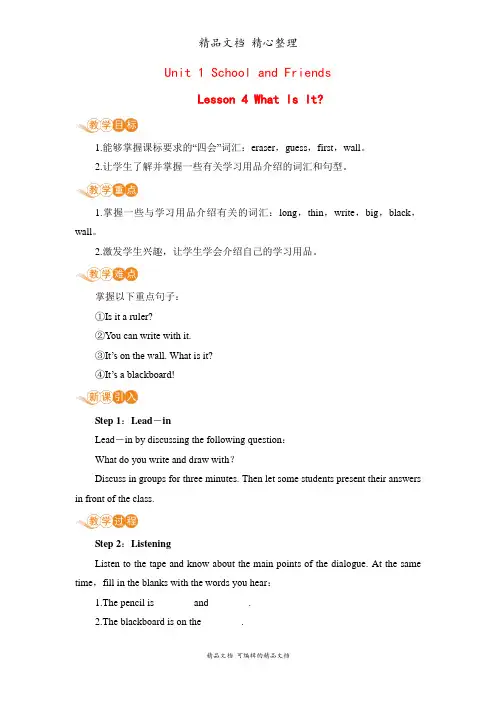
Unit 1 School and FriendsLesson 4 What Is It?1.能够掌握课标要求的“四会”词汇:eraser,guess,first,wall。
2.让学生了解并掌握一些有关学习用品介绍的词汇和句型。
1.掌握一些与学习用品介绍有关的词汇:long,thin,write,big,black,wall。
2.激发学生兴趣,让学生学会介绍自己的学习用品。
掌握以下重点句子:①Is it a ruler?②You can write with it.③It’s on the wall. What is it?④It’s a blackboard!Step 1:Lead-inLead-in by discussing the following question:What do you write and draw with?Discuss in groups for three minutes. Then let some students present their answers in front of the class.Step 2:ListeningListen to the tape and know about the main points of the dialogue. At the same time,fill in the blanks with the words you hear:1.The pencil is________and________.2.The blackboard is on the________.Finish the task in class orally.Step 3:ReadingRead the text and answer the following questions:1.What can we write with?2.What colour is the blackboard?Read the text and finish the task in class orally.Step 4:PracticeAsk the students to make up a dialogue to introduce classroom objects by themselves.Work in groups to finish the task. After a while,let some groups present their dialogues in front of the class.When the students are preparing,the teacher can walk around the classroom to solve the problems that probably happen.Step 5:Come to “Let’s Do It!”Listen to the tape and finish Exercise 1 together. Ask the students to finish Exercise 2 in groups.Ask the students to finish Exercise 3 by themselves.Finish Exercise 4 in “Let’s Do It!”.。
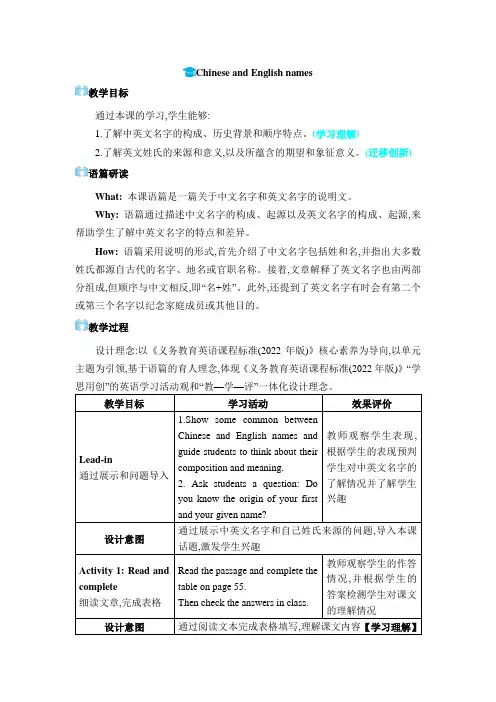
Chinese and English names
教学目标
通过本课的学习,学生能够:
1.了解中英文名字的构成、历史背景和顺序特点。
(学习理解)
2.了解英文姓氏的来源和意义,以及所蕴含的期望和象征意义。
(迁移创新)
语篇研读
What: 本课语篇是一篇关于中文名字和英文名字的说明文。
Why:语篇通过描述中文名字的构成、起源以及英文名字的构成、起源,来帮助学生了解中英文名字的特点和差异。
How:语篇采用说明的形式,首先介绍了中文名字包括姓和名,并指出大多数姓氏都源自古代的名字、地名或官职名称。
接着,文章解释了英文名字也由两部分组成,但顺序与中文相反,即“名+姓”。
此外,还提到了英文名字有时会有第二个或第三个名字以纪念家庭成员或其他目的。
教学过程
设计理念:以《义务教育英语课程标准(2022年版)》核心素养为导向,以单元主题为引领,基于语篇的育人理念,体现《义务教育英语课程标准(2022年版)》“学思用创”的英语学习活动观和“教—学—评”一体化设计理念。
反馈
板书设计
作业设计
基础型作业:Read the passage again and retell it.
实践型作业:Search the internet in groups for the meaning of the names in Activities 2 and 3.
教学反思。
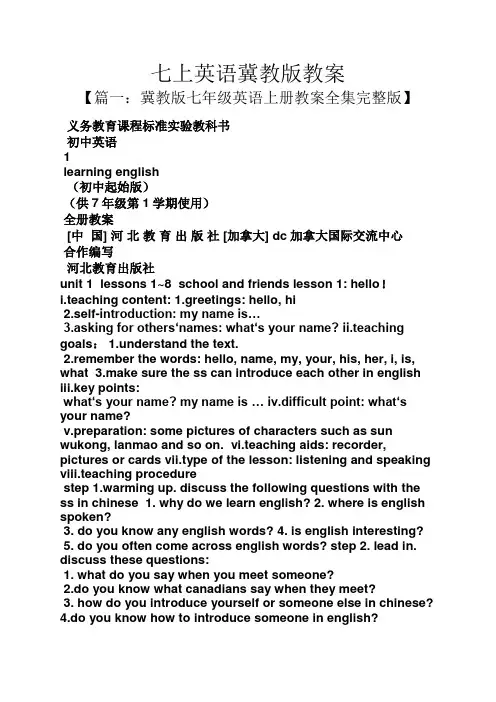
七上英语冀教版教案【篇一:冀教版七年级英语上册教案全集完整版】义务教育课程标准实验教科书初中英语1learning english(初中起始版)(供7年级第1学期使用)全册教案[中国] 河北教育出版社 [加拿大] dc加拿大国际交流中心合作编写河北教育出版社unit 1 lessons 1~8 school and friends lesson 1: hello!i.teaching content: 1.greetings: hello, hi2.self-introduction: my name is…3.asking for others‘names: what‘s your name? ii.teaching goals: 1.understand the text.2.remember the words: hello, name, my, your, his, her, i, is, what3.make sure the ss can introduce each other in english iii.key points:what‘s your name? my name is … iv.difficult point: what‘s your name?v.preparation: some pictures of characters such as sun wukong, lanmao and so on. vi.teaching aids: recorder, pictures or cards vii.type of the lesson: listening and speaking viii.teaching procedurestep 1.warming up. discuss the following questions with the ss in chinese 1. why do we learn english? 2. where is english spoken?3. do you know any english words?4. is english interesting?5. do you often come across english words? step 2. lead in. discuss these questions:1. what do you say when you meet someone?2.do you know what canadians say when they meet?3. how do you introduce yourself or someone else in chinese?4.do you know how to introduce someone in english?today we‘re going to learn something about them. do you want to know? step 3. new lesson:no. 1 hello/hi, my name is 1. presentationpretend to meet someone. s ay ―hello‖ or ―hi‖, my name is…. make sure the ss can understand it. encourage them to repeat.2. practicework in pairs. encourage the ss to greet each other and introduce themselves. then ask some pairs to act it out.no. 2. what‘s your name? 1. presentationsay ―my name is___. what‘s your name?‖ translate if necessary. then repeat a few times. encourage the ss to follow until they can say it correctly. 2. practicework in chain like this:a: (to b) my name is ___. what‘s your name? b: my name is___. (to c) what‘s your name? c: …then ask some ss to act it out. 3.listen and follow4. play the tape for the ss to follow.5.summary.sum up the lesson briefly by practicing all the dialogues in the text. 6.homeworkread the text and practice the dialogue. teaching reflection:lesson 2: how are you? i.teaching content1.greeting: nice to meet you2.teach the song ―how are you?‖ ii.teaching goals1.understand the text2.remember the mastery vocabulary3.understand and sing the song ―how are you?‖iii.key points: greet someone with the phrase ―how are you?‖ iv.difficult point: greeting and response in the textv.preparation1.prepare some pictures and put them on the bb2.write the new words on the bbvi.teaching aids: audiotape and some picturesstep 1. warming up. greeting and review. after greeting (hi, hello), review the dialogue in the last lesson briefly.step 2. lead in. ask the ss the questions in chinese: 1.what do chinese say when they meet each other?2.canadians don‘t ask the questions such as ―have you had your meal?‖ or ―where are you going?‖. do you know what they say expect ―hi‖ or ―hello‖ step3. new lesson1.presentation. explain that canadians greet each other by saying ―how are you?‖ and ―nice to meet you‖. explain the meaning of the expressions. encourage the ss to repeat a few times.2.listen and say. play the tape for the ss to follow.3.practice. work in pairs. encourage the ss to practice the dialogue in pairs. demonstrate the dialogue with one or two ss, and then ask some pairs to act it out for the rest of the class. step4. demonstrate and practice the dialogue: hello! my name is ___. what‘s your name? my name is ____ .nice to meet you. nice to meet you, too.step 5. teach the song ―how are you?‖1.go over the words of the song and practice them.2.explain the last line3.play the song for the ss to follow.step 6. summary. sum up the greeting and response, combining with the useful expressions in this lesson.step 7. homework.1.read and practice the dialogue.2.sing the song ―how are you?‖ teaching reflection:lesson3: my friends i.teaching content1. introducing others: he/she is my friend.2.what‘s her/his name? ii.teaching goals 1.understand the text2.remember the mastery vocabulary: boy, girl, teacher, iii.key point: he/she is my friend.iv.difficult point: plural forms of the nouns v.preparation1.prepare some pictures and put them on the bb2.write the new words on the bbvi.type of the lesson: listening, speaking, readingvii.teaching resources: audio tape, pictures in the classroom viii.teaching proceduresay ―hello, how are you?‖ mak e the ss respond correctly. then sing the song ― how are you‖step 2. teach the new words boy, girl, and teacher by pointing a girl/boy/yourself or pictures. explain the sentence ―this is a _____‖.step 3. let the ss to practice ―this is a ____‖ by point ing at someone.step 4. use the pictures to teach the new words: chair, book. demonstrate ― what‘s this? it‘s a ___‖. then practice them with the ss.step 5. teach the numbers one –five, using your fingers to show the meaning. then use the books on the desk to demonstrate. pay attention to the plural of the word ―book‖.step 6.encourage the s to practice the number by pointing boys, girls, desks, chairs, and books. then ask some ss o do this in front of the class. step 7. sum up the items briefly step 8. homeworkread the text. try to use the items in the classroom teaching reflection:lesson 4: my school i.teaching content 1.this is my school.2.new words: school,classroom, lab,library3.letters aa—ddii.teaching aims1.understand the text.2.remember the words: school, classroom, lab,library3.sing the song.iii.key point: this is____?iv.difficult point: the words of the song v.preparation before class1.some pictures of school, classroom and library2.write the new words on the bbvi.type of the lesson: listening, speaking, response and singing vii.teaching aids: audiotape, pictures viii.teaching procedure step1.warming up1.greeting. greet the ss with the expressions in l1 and l22.sing the song ―how are you?‖3.review the item ―this is a _____.‖ and ―what‘s this?‖ by pointing something4.count the numbers step2.presentationuse pictures to teach the words ―school,classroom, lab and library‖.step 3. practice. encourage the ss to practice in pairs, using books, chairs, desks, etc. play the tape for the ss to follow. then ask someone to demonstrate for the rest of the class.step 4. sum up the text briefly to consolidate the items.play ―hide –and –search‖ game to review ―where is___‖ step 5. homework 1.read the text 2.sing the song teaching reflection: lesson 5 : my classroom i. teaching content1.new words: pen, pencil, pencil case, marker, blackboard2.what‘s this? it‘s a _____.3.how many ____ do you have?ii.teaching aims 1.understand the text2.remember the new words3.ask and answer about ― how many____?‖ iii. key points1.what‘s this?2.how many___ ?iv. difficult points: the question ―how many___?‖ and the answers v. preparation1.prepare some pictures of school, classroom and library2.bring some real things such as pen, pencil, pencil case and markervi.teaching aids: audiotape, some pictures, books, pens, pencils and markers vii.type of the lesson: listening and speaking viii.teaching procedurestep 1. warming up. greet the ss and review the last lesson. ask some pairs to act out the dialogue like this:a: what‘s this?b: it‘s a ____. (using old words) step 2. presentationuse real objects or pictures to teach the new words. write them on the blackboard. play the tape for the ss to follow. step 3. practice.encourage the ss to practice ―what‘s this?‖ ―it‘s a ___, (using new words). then ask some pairs to act it out, using real things or pictures. step 4. presentation【篇二:冀教版七年级英语上第四单元教案】桑日中学备课教案授课时间: 年月日授课时间年【篇三:冀教版七年级上册英语教案lesson 15】课时教案。
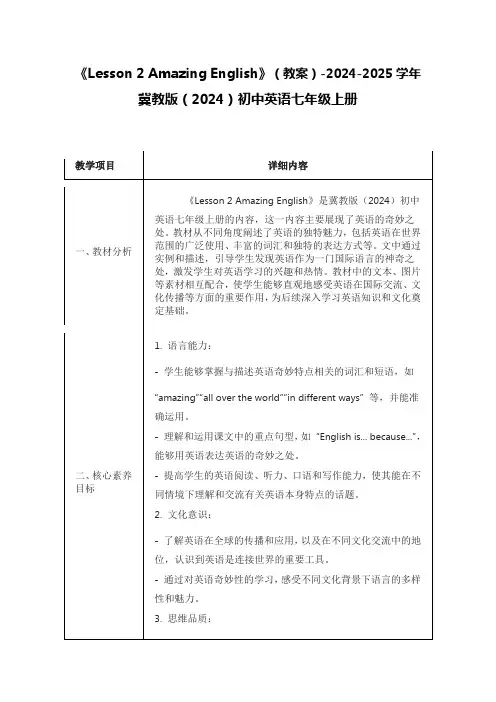
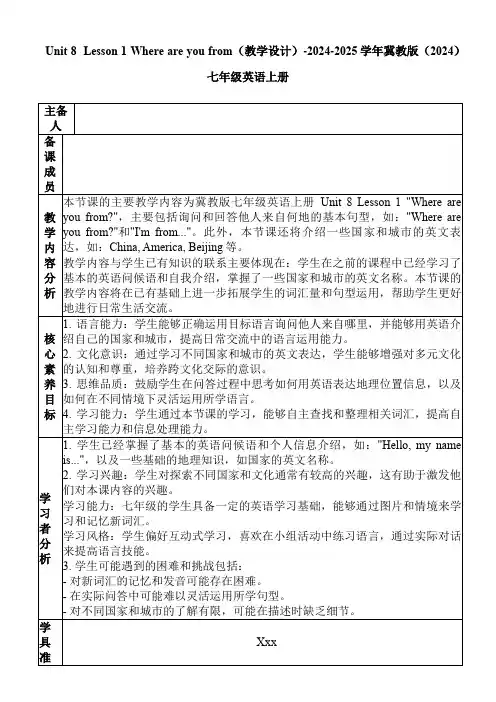
Lesson 2The rhino and the egret教学目标通过本课的学习,学生能够:1.获取和梳理本篇说明文的内容,了解犀牛和白鹭的故事,提取犀牛和白鹭如何共生的信息,形成信息结构图。
(学习理解)2. 通过介绍犀牛和白鹭的故事,意识到互帮互助的重要性,从而培养团队协作能力。
(应用实践)3.运用本课所学句型,结合信息结构图,学习用准确的语言讲述自己和同伴之间互帮互助的经历和体会。
(迁移创新)语篇研读What: 本课语篇是一篇说明文,主要介绍了白鹭和犀牛互帮互助的故事。
Why: 通过介绍犀牛和白鹭的互利共生关系,让学生深刻体会到互帮互助的重要性。
文章描述了动物互利共生关系的具体情境,激发了学生喜爱动物、热爱大自然的情怀。
How: 文章首先介绍了两种动物——白鹭和犀牛,接着讲述了他们两个如何互利共生,从而鼓励学生要乐于助人、帮助同伴。
教学过程设计理念:以《义务教育英语课程标准(2022年版)》核心素养为导向,以单元主题为引领,基于语篇的育人理念,体现《义务教育英语课程标准(2022年版)》“学思用创”的英语学习活动观和“教—学—评”一体化设计理念。
习理解】3:Careful Read the passage again and write how the rhino and the egret help each other.the rhino the egret理解,并向全班介绍自己的文章。
在实际教学中教师可以根据不同学生的水平予以不同的要求和反馈【迁移创新】Activity 6:Language points and exercise通过知识点的学习帮助学生解决后续学习中的问题nguage points:(1)help each other(2)stay healthy(3)one is…the other is…(4)have fun=have a goodtime=enjoy onself(5)to do 不定式作目的状语(6)tell sb. about sth.2.Exercises.教师观察学生对语言点的理解情况,能否独立完成相关的练习题,判断学生对知识点的掌握情况设计意图语言点的学习有助于帮助学生应对在答题过程中遇到的种种困难,语言点的讲解对于学生学习有十分重要的实际意义;通过做练习,进一步掌握本课的重点内容,巩固对语法的掌握【学习理解】板书设计Lesson 2The rhino and the egretHow do they help each other?the rhino the egret作业设计基础型作业:1.Read the lesson fluently.2.Recite the words and expressions in lesson 2.实践型作业:Interview your classmates or your friends about different animals that can live together and write a passage to share with us.教学反思。
2024冀教版七年级英语上册教案Unit 1 Good morningTeaching goals:1. Enable students to greet each other in English.2. Enable students to understand and use the expressions "good morning" and "goodbye" in English.3. Enable students to understand and use the expressions "How are you?" and "I'm fine, thank you" in English.Teaching procedures:Step 1. Warm-upGreet the students with "Good morning" and ask them to respond with "Good morning" as well.Step 2. PresentationShow the expressions "good morning", "goodbye", "How are you?" and "I'm fine, thank you" on the board and explaintheir meanings.Step 3. PracticeAsk students to practice the expressions with a partner. Monitor their pronunciation and usage of the expressions.Step 4. ListeningPlay an audio clip of the expressions and ask students to listen and repeat after it.Step 5. Role-playDivide the class into pairs and ask them to perform arole-play using the expressions they have learned.Step 6. SummaryReview the expressions learned in the lesson and ask students to summarize what they have learned.Step 7. HomeworkAssign homework to the students, which is to greet their family members using the English expressions they have learned.。
2024七年级冀教版英语上册教案一、教学目标1. 学生能够掌握冀教版英语上册的基本词汇和句型,如“good morning”“what's your name”等。
2. 学会正确的发音,能够流利地朗读课文。
3. 通过情景对话,提高学生的口语表达能力和交际能力。
4. 培养学生对英语学习的兴趣,让他们积极主动地参与课堂活动。
二、教学重点与难点重点:掌握基本词汇和句型,正确发音和朗读。
难点:学生可能在口语表达和情景对话中感到困难,比如不敢开口说英语,或者不知道如何用英语表达自己的想法。
三、教学方法1. 情景教学法:设置各种生活场景,如在学校、在家里、在超市等,让学生在情景中学习英语。
比如,在学校场景中,学习“Hello, teacher!”“Good morning, classmates!”等句子。
2. 游戏教学法:设计有趣的英语游戏,如单词接龙、猜谜语等。
比如玩单词接龙游戏,第一个学生说一个单词,下一个学生用这个单词的最后一个字母作为开头,说一个新单词,这样可以帮助学生快速记忆单词。
激发学生的学习兴趣,提高学习效果。
四、教学过程(一)导入同学们,咱们先来轻松一下哈。
老师给大家播放一首超级好听的英文歌曲《Big Big World》。
大家仔细听,感受一下这优美的旋律和英语的魅力。
(播放歌曲)好啦,歌曲听完了。
同学们,这首歌好不好听呀?(学生回答:好听。
)那大家有没有注意到歌曲里的一些英语单词和句子呢?(学生回答各种听到的单词和句子。
)非常棒!今天呀,我们就一起走进冀教版英语上册的奇妙世界,去探索更多有趣的英语知识。
(二)知识讲解1. 课本原文内容展示(以第一单元为例)“Hello! I'm Li Ming. Nice to meet you!”“Hi! I'm Jenny. Nice to meet you, too!”同学们,咱们来看这句话“Hello! I'm Li Ming. Nice to meet you!”这句话是什么意思呢?(学生回答:你好!我是李明。
冀教版七年级英语上册教案英语教师上课必须要充分备课,写好英语教案。
下面是我为大家精心推荐的,希望能够对您有所帮助。
Lesson3 Boy, Girl and Teacher一、 Teaching content1. The statement "This is a teacher/boy/girl2. Number one—five二、 Teaching goals1. Understand the text2. Remember the mastery vocabulary: boy, girl, teacher, chair, book, desk, one—five三、 Key point: This is ____; Number one to five四、 Difficult point: plural forms of the nouns五、 Preparation1. Prepare some pictures and put them on the Bb2. Write the new words on the Bb3. Bring ten books on the teachers desk六、 Type of the lesson: listening, speaking, reading七、 Teaching resources: audio tape, pictures, books, chairs and desks in the classroom八、 Teaching procedure九、 Teaching procedure Design for activitiesSay "Hello, how are you?" make the Ss respond correctly. Then sing the song " How are you" Step 2. Teach the new words boy, girl, and teacher by pointing a girl/boy/yourself or pictures. Explain the sentence "This is a _____".Step 3. Let the Ss to practice "This is a ____" by pointing at someone.Step 4. Use the pictures to teach the new words: chair, book. Demonstrate " Whats this? Its a ___". Then practice them with the Ss.Step 5. Teach the numbers one five, using your fingers to show the meaning. Then use thebooks on the desk to demonstrate. Pay attention to the plural of the word "book".Step 6.Encourage the S to practice the number by pointing boys, girls, desks, chairs, and books. Then ask some Ss o do this in front of the class.Step 7. Sum up the items brieflyStep 8. HomeworkRead the text. Try to use the items in the classroomLesson 4 Where一、 Teaching content1. Where is___?2. New words: classroom, library3. Sing the song二、 Teaching aims1. Understand the text2. Remember the words: where, school, classroom, library3. Sing the song三、Key point: Where is____?四、Difficult point: the words of the song五 Preparation before class1. Some pictures of school, classroom and library2. Write the new words on the Bb3. Bring 5 pictures about the song六、 Type of the lesson: listening, speaking, response and singing七、 Teaching aids: audiotape, pictures八、 Teaching procedureStep 1. Warming up1. Greeting. Greet the Ss with the expressions in L1 and L22. Sing the song "How are you"3 Review the item "This is a _____." and "Whats this?" by pointing something4. Count the numbersStep 2. Presentation1. Use pictures to teach the words "classroom, school, and library".2. Pretend to look for your book everywhere, saying, "Where is my book?" Then point to thebook and say "There it is". Write the sentence on the Bb.Step 3. Practice. Encourage the Ss to practice in pairs, using books, chairs, desks, etc. Play the tape for the Ss to follow. Then ask someone to demonstrate for the rest of the class.Step 4. Presentation: go over the words of the song1. Do actions to demonstrate jump, look, point, reach, sit and stand, adding up and down. e.g. look up/down.2. TPR activities. Demonstrate "order and response" with one student. Say "stand up, look up" and so on, and encourage the student to respond. Then do the same with the rest of the class.3. Practice. Work in pairs. One gives the orders and the other do the actions.4. Go over the words of the song. Make sure the Ss understand them.5. Chant and sing.①Play the tape for the Ss to follow.②Practice in pairs③Do it togetherStep 5. Sum up the text briefly to consolidate the items. Play"Hide and search" game to review "Where is___"Step 6. Homework1. Read the textSing the song七年级英语课堂教学实践探微摘要:在中学英语课堂教学中,引入快乐学习法有助于活跃教学气氛,促进教学效果的提升。
首先分析了快乐学习法在中学英语课堂中的应用意义,然后结合当前的教学情况,提出了将快乐学习法引入课堂的方法,以期为广大教师的课堂改革提供参考。
关键词:中学英语;课堂教学;快乐学习法;意义;策略在初中英语的教学过程中,提高课堂效率是一个长期的话题。
要使学生在有限的课堂时间内学到更多的知识,教师就必须采用寓教于乐的教学方式。
将快乐学习法应用于日常教学中,不仅能迅速提高课堂效率,还能从根本上引起学生的兴趣,变被动接受为主动追求。
一、将快乐学习法引入中学英语课堂的意义1.活跃课堂气氛,吸引学生参与在目前的教学模式中,教师与学生交流较少,教学缺乏反馈过程,课堂也变得没有活力。
引入快乐学习法,在课堂上设计一些有趣的交流环节,吸引不同英语水平的学生参与,能够改变枯燥的英语课堂。
为课堂注入新鲜感之后,学生将会产生更为强烈的参与感,从而改变他们对英语学习的心态。
2.倡导主动学习,提升学习兴趣主动学习,意味着教师要引导学生转变思维方式,重视快乐学习的作用。
学生是学习的主体,只有将被动转化为主动,才能真正提升英语课堂的教学效率。
在教学过程中,教师应当起到指导作用,合理安排课堂内容,逐步培养学生为自己学习的意识,提升学生的学习兴趣,最终实现乐学的效果。
3.提高课堂效率,实现素质教育为了响应国家进行素质教育的号召,中学英语也应当注重培养学生的综合素质。
在课堂上,教师需要多采取让学生感到快乐的教学方式,改变以往只有知识点讲解的课堂结构,引入新方法,从"听、说、读、写"各个方面展开教学工作,以此来提高课堂的效率,达到培养综合性人才的目的。
二、将快乐学习法引入中学英语课堂的实践方法1.课前做好铺垫,感受英语乐趣在正式上课前和课堂刚开始的一段时间内,教师应引入课堂话题,铺设生活情境,以此来吸引学生的注意力。